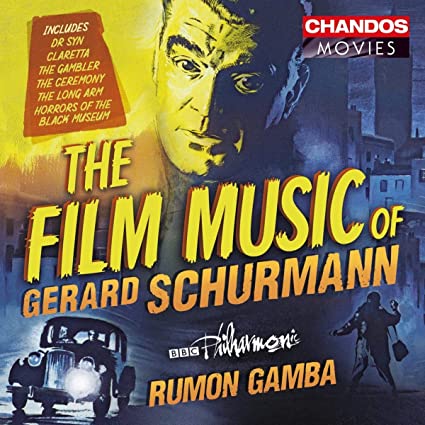
BBC Philharmonic, Yuri Turchinsky, leader
Rumon Gamba, Conductor
CD Booklet Notes by Carolyn Nott
Chandos Digital Chan 10979, 2019
1-8: DR SYN, ALIAS THE SCARECROW, Suite For Orchestra (1963) – 20:49
9-10: KONGA, Suite For Orchestra (1961) – 4:23
11-14: CLARETTA, Suite For Orchestra (1984) – 9:25
15-20: THE CEREMONY, Suite For Orchestra, Anthony Robb, Recorders, Indian Flute (1983) – 16:37
21: TAILING THE SUSPECT FROM “THE LONG ARM” (1956) – 1:48
22-23: HORRORS OF THE BLACK MUSEUM, Suite For Orchestra (1959) – 5:18
24-28: THE GAMBLER, Suite For Orchestra (1997) – 15:48
29: ATTACK ON THE IRON COAST (Main Title)(1967) – 3:21
Total track Time = 78:25
Rating: ****
While Gerard Schurmann is perhaps not as well known to newer film music fans as he composed only a handful of scores in the 1950s and 1960s often for B-pictures gaining more attention when he scored crime drama for the British Ealing Studios. He also worked as an orchestrator on a few projects including Ernest Gold’s Exodus and Maurice Jarre’s Lawrence of Arabia. Rumon Gamba and the BBC Philharmonic have pulled together selections from eight of Schurmann’s more popular and important scores across his entire output, including music from his last score (to date), The Gambler (1997). The music is presented more to create a concert listening experience rather than a chronological, or thematic one. For those familiar with Chandos’ film music series, this will come as another welcome addition.
Things get off to a fine start with an extensive collection of eight pieces from Dr. Syn, Alias The Scarecrow (1963). Patrick McGoohan helmed this 18th-Century adventure about a masked rider out to help a town overcome terrorizing by Naval press gangs coupled with the King’s oppression. After the smugglers get on the beach, there is a nice little chase sequence to get things off; there is also some thrilling music for the later “Escape”. The second movement is a rather intriguing thematic statement for Dr. Syn with an interesting chromatic wandering that breaks into a moment of beauty for winds. The music here blends these very lyrical moments filled with plenty of subtle colors. Thematic references float through the different parts of this eight-movement suite giving us a musical glimpse of the story as it progresses. The delicate orchestral colors are rather fascinating against the somewhat tempered swashbuckler references in the action tracks like “Flight From the King’s Men”.
Some of Schurmann’s most intriguing work was for the 1950s British horror film scene which would lead to more mainstream work. Selections from two of these are featured here. There are two selections each from these films, both which starred Michael Gough, from first Konga (1961; a sort of bad King Kong). The second selection, “A Sad Conclusion”, has an almost Jarre-like feel. Music from the Horrors of the Black Museum (1959; released in Hypnovision as the story is about an unsuccessful crime novelist who hypnotizes his assistant to commit different crimes so he can be more accurate in his stories) appears a little later. Here is the more intense and Gothic-like British horror scoring that fans of the genre will certainly be thrilled to hear right from its intense opening main titles and fascinating shift into the “London Traffic”. Probably one of the highlights of the album wit its often overtly-dramatic writing.
Among the more higher film endeavors was Claretta Patacci (1984), Schurmann’s penultimate score. The lavish film focused on the final days of Mussolini’s mistress. The four selections here include a touching theme for Claretta and a light waltz. The music has a very intricate feel and a more restrained approach where themes just catch one off guard beautifully moving to a grand “End Title”. Music from two crime dramas follows. First are selections from The Ceremony (1963) which starred and was directed by Laurence Harvey. Robert Walker, Jr. won a Golden Globe for his performance and the film was also nominated in the foreign film category. Schurmann adds plenty of Spanish color in the nuanced thematic writing here. His music gets at the underlying troubles of the characters through interesting dissonant sections. The orchestral color is one of the highlights of this particular suite with nods to its North Africa setting (“Tangiers”). The “Escape” and “Prison Revolt” add a bit of tension and excitement to close things off. Gamba also includes a selection from Schurmann’s first Ealing film score, The Long Arm/The Third Key (1956), “Tailing the Subject” which features an interesting trumpet thematic statement and an almost light Hindemith harmonic structure.
Five selections from Schurmann’s last film score The Gambler, based on the Dostoevsky novel. This is an overall darker, and moodier score. One of the more fascinating sections comes in the fourth movement “Carriage Ride” section. The final movement opens into a gorgeous waltz with hints at the earlier darkness in a really wonderful “Romanza”. The album concludes with the thrilling “Main Title” from Attack on the Iron Coast (1967) blending Schurmann’s modernist and romantic stylistic qualities.
Performances here are excellent in keeping with previous outings in this series. American film music fans may be struck by the more restrained writing and unique orchestral sound of Schurmann’s music that flows quite consistently across the works represented. The album gives listeners a chance to hear Schurmann’s approach across several genres in full, orchestral sound that helps perfectly create mood and atmosphere
—Steven A. Kennedy
A version of this review originally appeared in Film Score Monthly in 2019.
Copyright, Film Music Review, 2022. All Rights Reserved.
